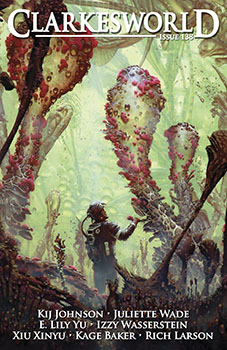“Tool-Using Mimics” by Kij Johnson
Reviewed by Victoria Silverwolf
The latest issue of this on-line magazine offers five new stories by women.
The inspiration for “Tool-Using Mimics” by Kij Johnson is a vintage photograph, altered by artist Laura Christensen into the image of a young girl with tentacles. The author provides several reasons why such a being might exist. Although written in a poetic style, this collection of vignettes has no real plot.
The protagonist of “The Persistence of Blood” by Juliette Wade is a woman who has borne four children. Her most recent childbirth left her badly injured, and she wishes to avoid another pregnancy. This requires changing the laws of her society. An unexpected tragedy forces her to face new challenges. The setting is a complex, exotic one, with many strange details. As imaginative as these may be, many of them are irrelevant to the story.
“Unplaces: An Atlas of Non-existence” by Izzy Wasserstein consists of a series of notes written in the margins of a book of imaginary places. These messages tell of a violent insurrection tearing apart the United States. This brief work is more of a mood piece than a fully developed story.
In “Farewell, Adam” by Xiu Xinyu (translated by Blake Stone-Banks), one hundred people share the mind of a single celebrity. The concept is an interesting one, but not always clear. Careful reading is necessary for a full appreciation of this intriguing story.
Told in the style of a folk tale, “The No-One Girl and the Flower of the Farther Shore” by E. Lily Yu tells of a child who lives alone after the death of her grandmother. Eager to win a prize for the most beautiful object brought to a village festival, she obtains an extraordinary flower from her grandmother’s grave. The events that follow are tragic, ironic, miraculous, and inspiring. The author uses simple, elegant language to create a work of great power.
Victoria Silverwolf would like to point out that one story in this issue is more than twice as long as the other four stories combined.
 Clarkesworld #138, March 2018
Clarkesworld #138, March 2018